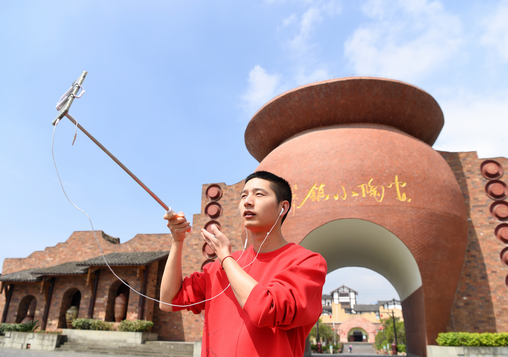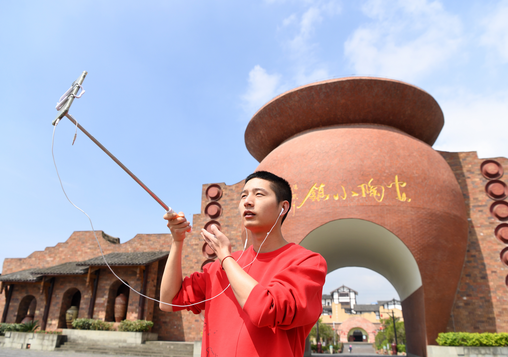
BEIJING, Nov. 26 (Xinhua) -- China has beefed up efforts to boost the development of smart tourism.
More supportive measures for "Internet + Tourism", including the construction of smart scenic spots, encouragement of online marketing, enhancement of tourism safety surveillance and online complaint settlement, etc, will be introduced to underpin the “Internet+Tourism” development, the State Council Executive Meeting mentioned recently.
In recent years, the Internet has brought forth a number of new business modes of tourism and boosted the upgrading and iteration of tourism.
The integrated development of Internet and tourism adds new highlights to the tourism consumption, and changes the way of travel.
Driven by the stronger national support of "Internet + tourism", the digitalization development of tourism in China will further speeds up.
--Dream of "cloud-based tourism" comes true
In 2020, "cloud-based tourism" becomes highly popular. The National Museum of China and Dunhuang Academy launched projects of "cloud visit to museums at home" that enable visitors to appreciate national treasures at home, which increased the sales of cultural creative products of museums.
The data showed that in the first live streaming of the Potala Palace, 920,000 viewers flooded online in the first hour, equivalent to 60 percent of its annual visitor's number.
Although the offline tourism is recovering day by day under the regular epidemic prevention and control, the "cloud-based tourism" remains a vital part of tourism industry.
Many tourists have been accustomed to make preparation in advance such as learning basic information by online guides of scenic spots, getting familiarized with travel routes by the live streaming of experienced guides, and reading comments of other tourists.
So far, a great number of attractions and scenic sites offered abundant online tourism resources that facilitated the readiness of tourists, making their trips more targeted and insightful.
Recently, Southwest China's Sichuan Province has launched a culture and tourism resources cloud platform, the only provincial cloud platform in China concentrating on cultural and tourism resources.
By September, the platform gathered 2.71 million pieces of data in six major cultural categories, covering ancient books, collections of art museums, local operas, traditional instruments and music, intangible cultural heritage and cultural relics, and 245,500 pieces of data in eight major tourism categories, including geographical landscape, water landscape, biological landscape, astronomical and climate landscape, etc. The database contains around 450 million words of resource descriptions, around 3 million pictures and 14,000 videos.
The platform realizes both management and query of cultural and tourism resources, and serves both the cultural and tourism industrial administrators and the mass people.
-- Scenic spots become smarter
In 2011, China proposed to set "smart tourism" as the development goal of China's tourism industry in the next decade.
Following the proposal, the construction of smart scenic spots, including smart parking, traffic diversion, intelligent guide, etc., has been extensively carried out throughout the country.
After the outbreak of COVID-19, the reservation and contactless tourism modes attracted more attention and thus accelerated the construction of smart scenic sites objectively.
In July, the Mount Longhushan in east China's Jiangxi Province announced the construction of China's first AI holistic smart scenic spot by integrating smart elements in all aspects like on-site service, scenic spot management, marketing and publicity.
In the upcoming three years, the Longhushan will utilize big data and AI technologies to achieve data interaction and AI empowerment in refined maps, AI smart guide, AR real scene, VR panorama, smart sightseeing bus, smart parking lot, security management and personnel dispatching so as to provide tourists with AI holistic smart tourism in a real sense .
With the evolution of travel habits, the sightseeing mode is phased out by experience-based tourism, which means tourists pay more attention to the interaction and experience in travel, and have higher demand on digitalization of scenic spots.
The pandemic does not stop people from pursuing a better travel life, but speeds up the advent of a smart tourism era, said by Sun Jie, CEO of Ctrip.com, adding that the industry should focus on the development of smart scenic spots, smart hotels, digitalization, and online guides in the future.
-- Tourism sector sees new promotional paths
For larger tourist attractions and scenic spots, the role of online marketing and promotion is further highlighted.
This year, many scenic spots tried to save themselves from the dilemma by live stream marketing amid the novel coronavirus outbreak.
For instance, Zhangjiajie in central China's Hunan Province publicized beautiful scenery and sold local delicacies through live streaming, which further consolidated its reputation and laid a solid foundation for rapid recovery.
According to China Employment Training Technical Instruction Center (CETTIC), internet marketing is among the ten newly added occupations in China.
The systematic and in-depth understanding of local tourism resources can not only promote sales of individual tourism products, but also lead the growth of tourism industry chain, which is the new requirement of future online tourism marketing. (Edited by Yang Yifan with Xinhua Silk Road, yangyifan@xinhua.org)




 A single purchase
A single purchase









